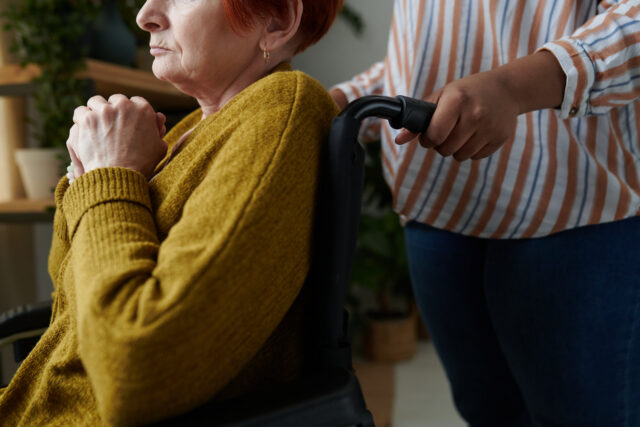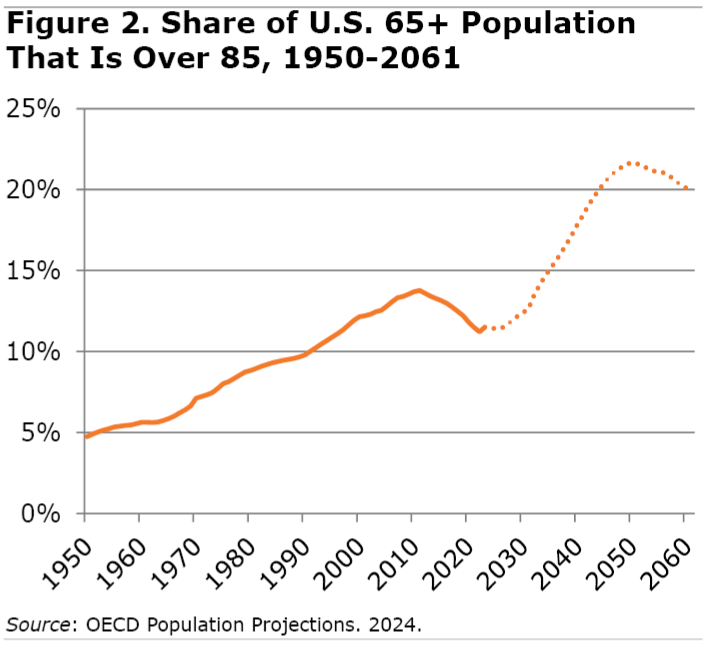
Immigration and Caregiving: Who Will Care for Aging Boomers?
With Americans having fewer children and the baby boomer cohort rapidly retiring, it has been immigrants who have been shoring up the U.S. workforce. According to the Migration Policy Institute, U.S. Census data show that – from 2000-2022 – the number of U.S.-born residents of prime working age (25-54) grew by just 2.9 million, while the number of prime-working-age immigrants (both documented and undocumented) rose by 7.7 million. During this same period, the 65+ population increased by 18 million.
The Elder Care Workforce
Immigrants have become especially important in elder care. According to KFF, immigrants make up 28 percent of the overall direct long-term care workforce (see Figure 1). Other studies report broadly similar estimates. As this chart shows, a majority of these workers are naturalized citizens, but many are non-citizens.

Limiting Immigration
A substantial number of non-citizen immigrants will soon lose their authorization to work as President Trump ends their protected status over the next several months. There are a few million immigrants with limited status, including asylum applicants, DACA holders, individuals with temporary protected status (including those from Haiti and Venezuela) and grants of parole (including immigrants from Afghanistan and Ukraine).
Immigrants without documentation also play a significant role in providing elder care. According to reports, while many of these individuals are afraid to go to work during the current immigration crackdown, most still do so since they need to support themselves and their families.
Just When We Need More Elder Care Workers
Limiting the number of potential care workers comes at a critical time as the baby boomers age. The oldest boomers will reach age 85, when the likelihood of needing assistance increases dramatically, in just six years. Due to this surge, and growing lifespans, the share of the age 65+ population that is over 85+ is projected to double – from about 10 to 20 percent – in the next two decades (see Figure 2).

In short, just as we need more people willing to take on the grueling job of providing hands-on care to those who cannot care for themselves, the Trump administration is making it more difficult for many of those who would provide such care to come to the United States or for those already here to stay in the workforce.
For more from Harry Margolis, check out his Risking Old Age in America blog and podcast. He also answers consumer estate planning questions at AskHarry.info. To stay current on the Squared Away blog, join our free email list.
Comments are closed.







I’m sure their children, nieces and nephews will be happy to fill the gaps. The already astronomical costs of care will be pushed even higher I’m sure.
i have wonderful children, nieces and nephews but they are living a long ways away, have there on very busy lives to manage and they have careers that don’t have room for another “caregiving” job. We need the immigrants to help us
Eldercare caregivers can enter the US legally through various visa options, including the H-2B visa for temporary non-agricultural jobs and the EB-3 visa for permanent residency. The H-2B visa allows family sponsors to hire foreign caregivers, while the EB-3 visa offers a pathway to permanent residency for caregivers who meet specific eligibility criteria. It is essential for caregivers to understand the requirements and process for each visa type to ensure a smooth entry into the United States.
Easier said than done. Have you tried sponsoring a foreign worker to care for your loved one, like a parent? I tried researching how to do this and have gotten nowhere. One thing I can’t understand why the US won’t grant J-1 visas for Aupairs to care for the elderly like they can for young kids. Other countries do it with great success. There are plenty of agencies that sponsor Aupairs.
Brain surgeons apart, there is never, ever a shortage of workers, only a shortage of workers at a particular wage. Pay what is needed to attract an adequate supply of suitably qualified people
This is just fearmongering. There are many immigrants who do caregiving, true. There is also many Americans doing caregiving. The immigrants from Nigera and Africa use this type of work as a way to enter the USA and to work. However, culturally, many of them are NOT a good fit for the patients they serve. They have no idea what being a caregiver is when they arrive. I am a former RN (USA born), and I can tell you if ANY job pays well it will attract the proper people to do the work. What we need is a well trained workforce to do the caregiving, not just immigrants.
What did they think would happen?? The very people they wish to exclude from this country are the people wiping their butts, caring for their children, working in the fields to pick their food. construct their homes and bring them their cocktails on holiday. Up until now, white people in America never did these jobs and now, either white man does more labor or everything basically falls apart.
This article conflates Legal Immigration with Illegal Immigration. Nobody disagrees with the need for the former, and everyone is waking up to the horrific consequences of the latter.
It is certainly true that the elderly do and will continue to have care options that are not exclusively reliant upon non-citizen immigrants. We know with certainty, however, that the expansive growth of the elderly population and the reduction in the supply of elder care workers who do this work (due to deportation of non-citizen immigrants, their reluctance to work because of fear of deportation, or making it more challenging/costly for them to enter the US via new or established visa programs, etc.) will result is two things simultaneously: (1) more demand for elder care services, and (2) less supply of such services. Anyone who paid attention in Economics 101, knows this will result in either higher prices for elder care, a scarcity of its availability, or both.
One can certainly prefer a President or a Political Party that favors a more restrictive immigration policy. Tens, if not hundreds, of millions of people do. However, one should also recognize that there are absolutely real economic consequences to such policies…in this case, harder to find, or more expensive elder care. One is either mistaken or being disingenuous in stating that our current “elderly” demographic shift and immigration policies won’t have this result.
We had better get the family unit back together or things will continue to get worse. We have lost our priorities along with our moral compass.
This is a really timely and powerful piece. You highlight a crucial link between immigration policy and elder care — especially how immigrants are making up a significant portion of the long-term care workforce. I love how you don’t just present the problem, but also illuminate the real economic and human costs: as baby boomers age, demand for care is rising sharply, yet restrictive immigration policies could choke off the very people who are most likely to provide that care. Thank you for drawing attention to this often-overlooked tension and reminding us how essential care work truly is.